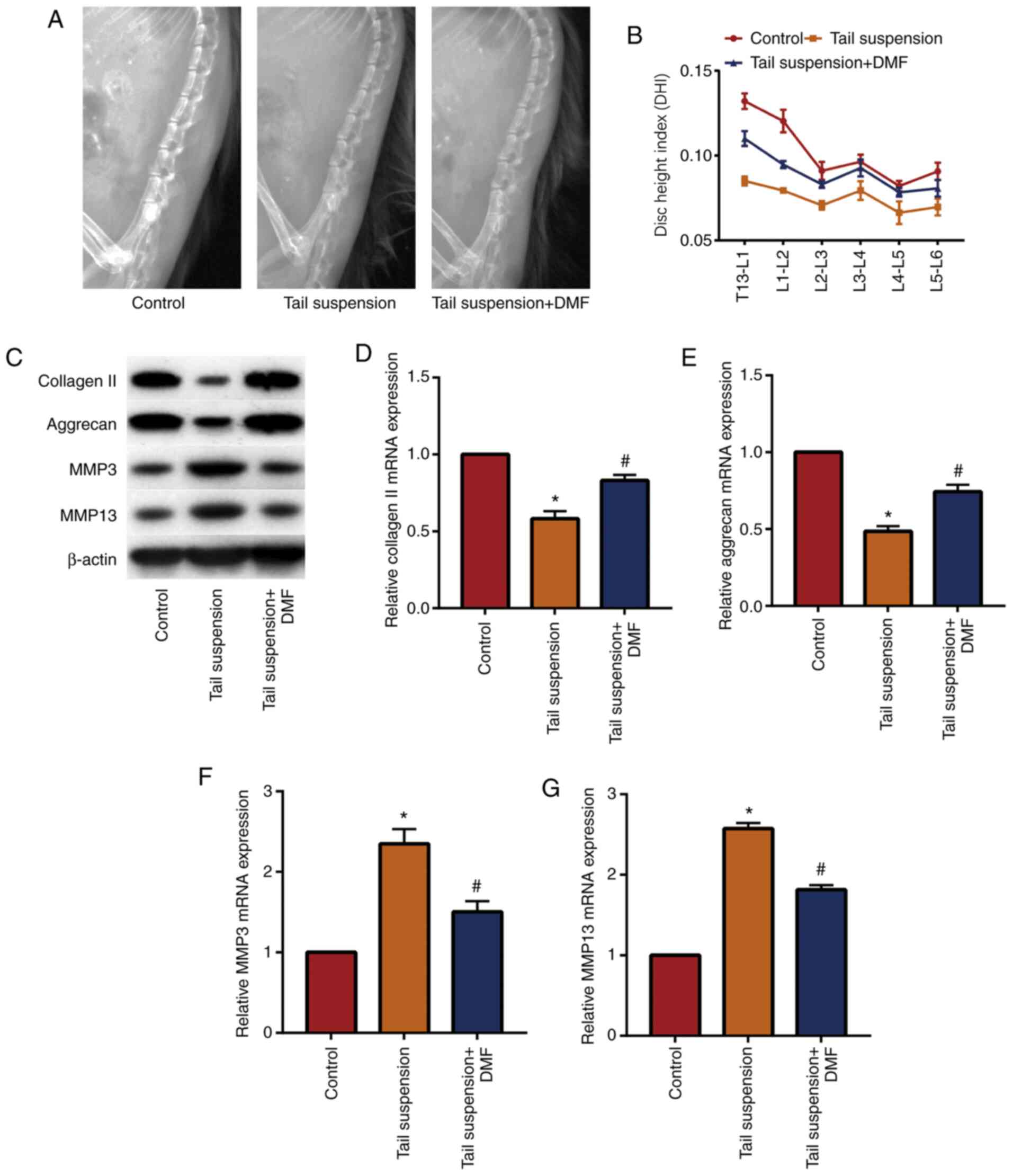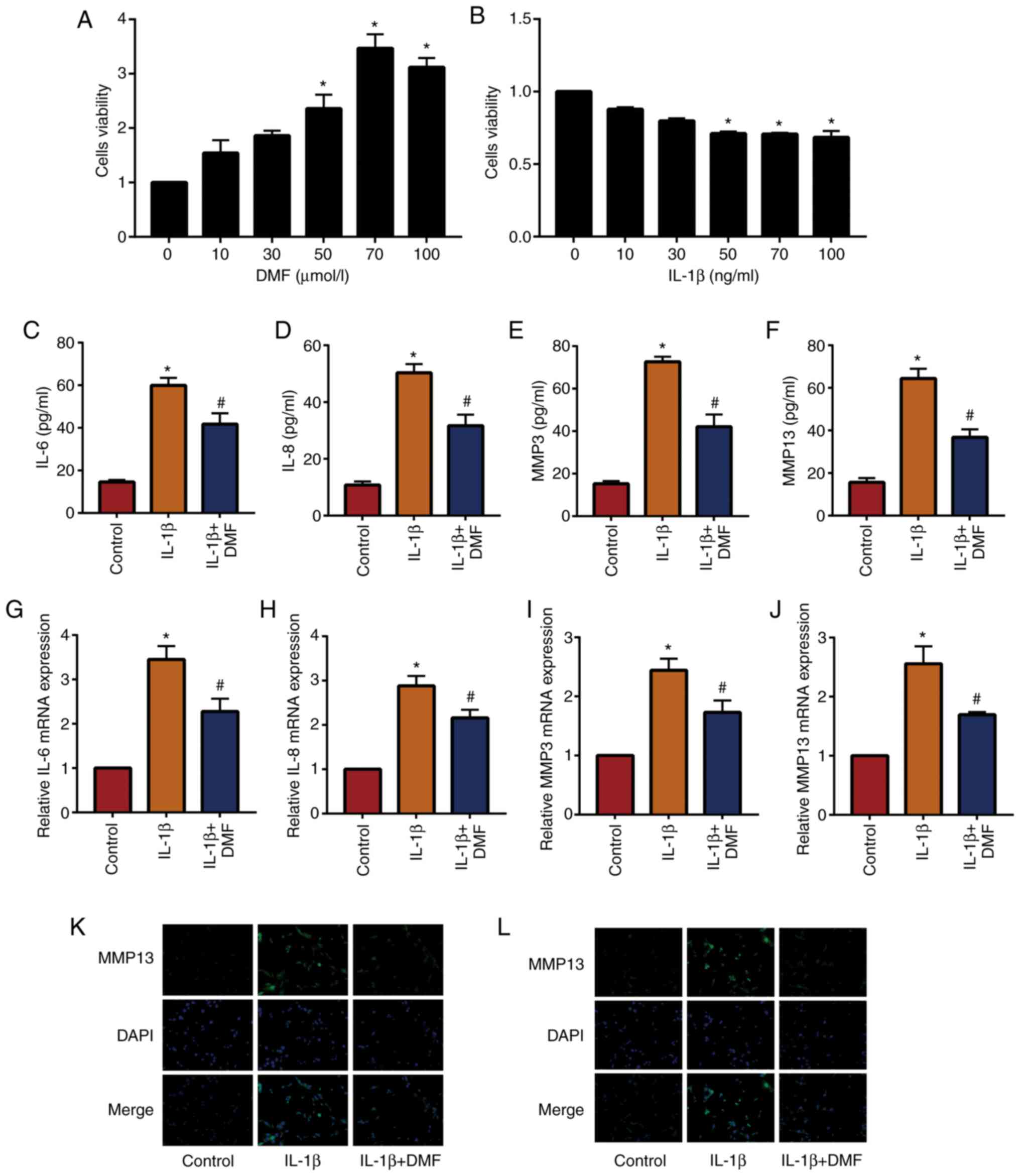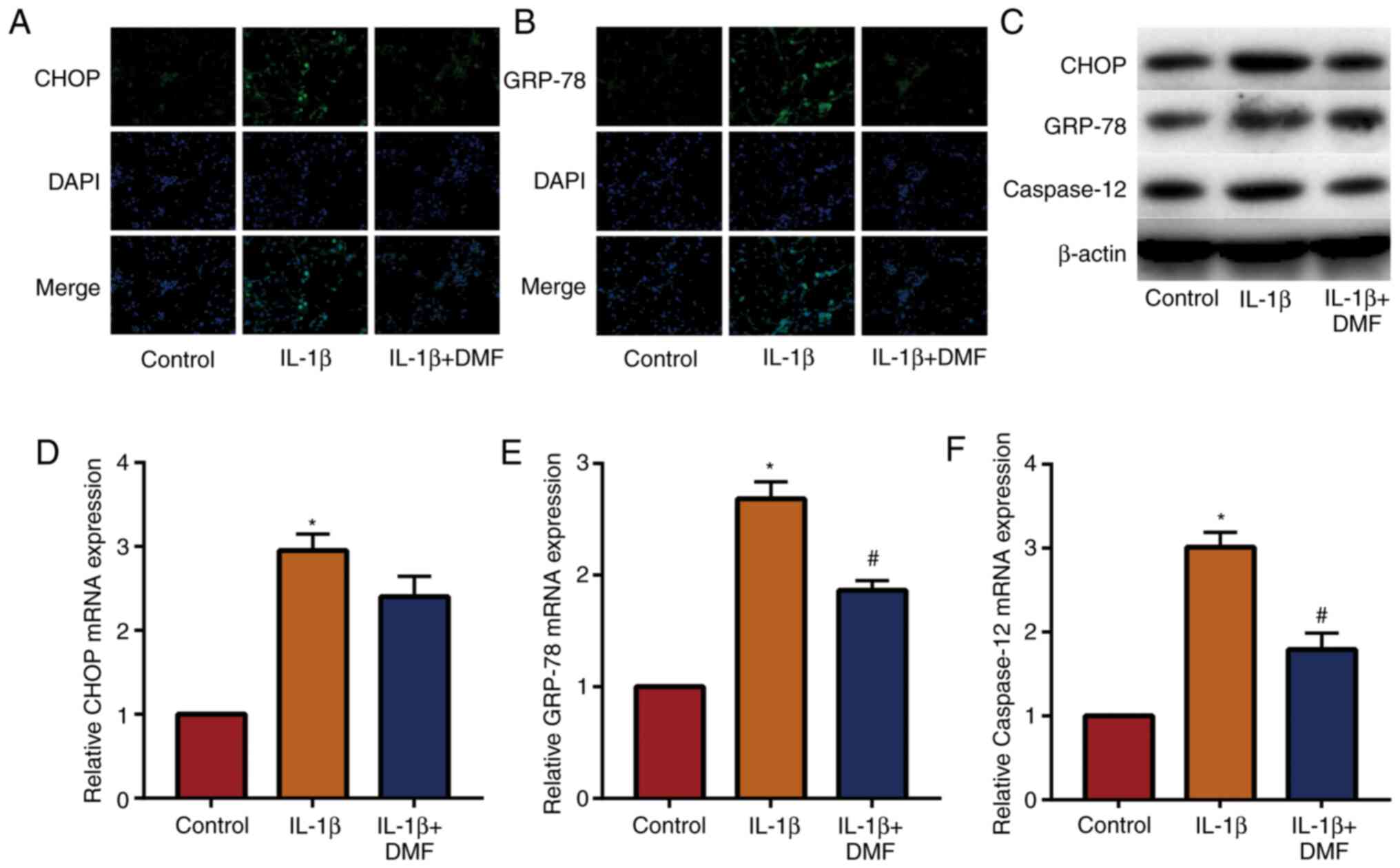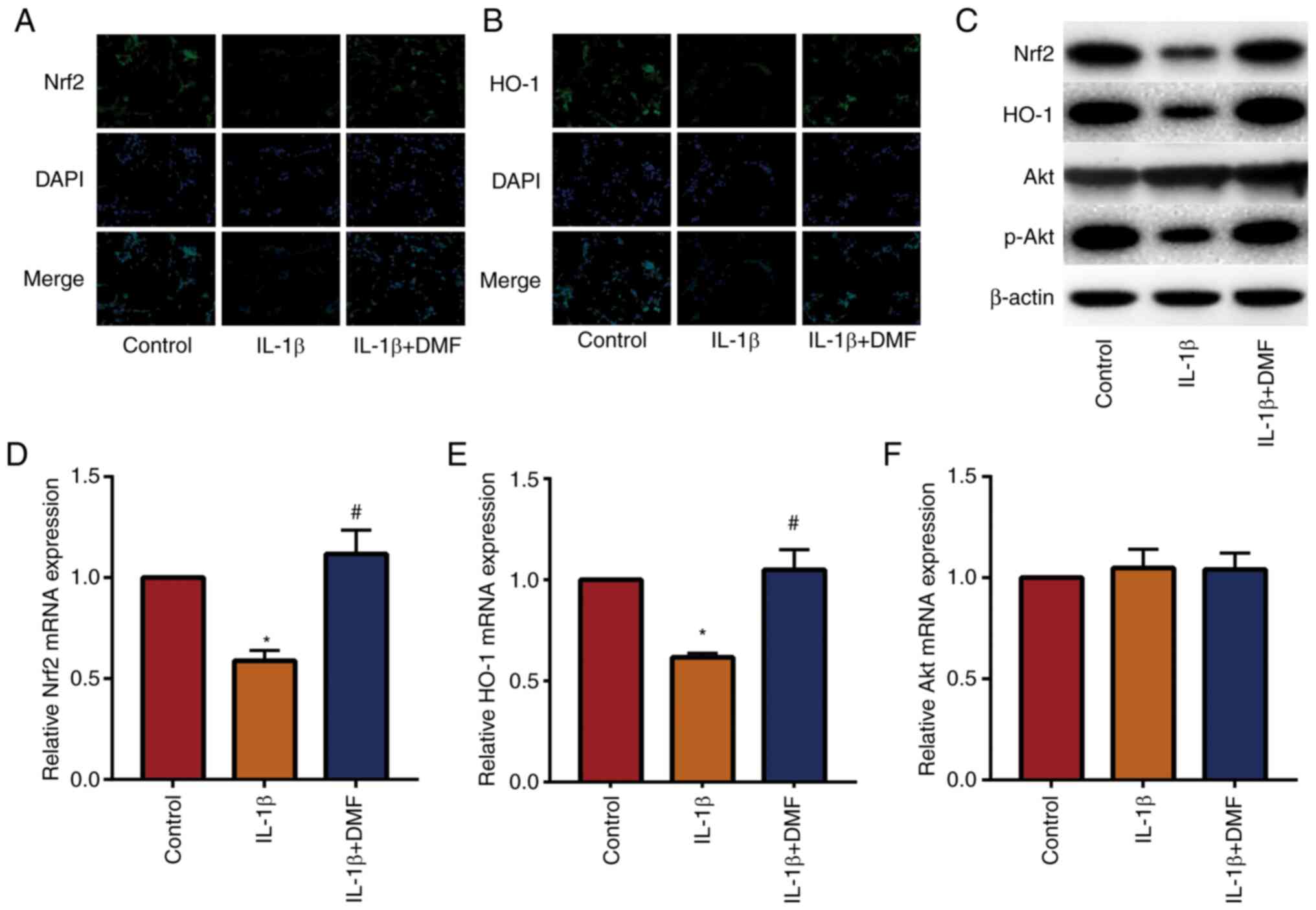|
1
|
Wu CZ, Ou DQ, Rong LM, Xu YC, Dong JW, Fan
L and Wang QY: Expression of lamin A/C protein in degenerated human
intervertebral disc. Eur Rev Med Pharmacol Sci. 22:7607–7613.
2018.PubMed/NCBI View Article : Google Scholar
|
|
2
|
González Martínez E, García-Cosamalón J,
Cosamalón-Gan I, Esteban Blanco M, García-Suarez O and Vega JA:
Biology and mechanobiology of the intervertebral disc. Neurocirugia
(Astur). 28:135–140. 2017.(In Spanish). PubMed/NCBI View Article : Google Scholar
|
|
3
|
Navone SE, Marfia G, Giannoni A, Beretta
M, Guarnaccia L, Gualtierotti R, Nicoli D, Rampini P and Campanella
R: Inflammatory mediators and signalling pathways controlling
intervertebral disc degeneration. Histol Histopathol. 32:523–542.
2017.PubMed/NCBI View Article : Google Scholar
|
|
4
|
Lin X and Lin Q: MiRNA-495-3p attenuates
TNF-α induced apoptosis and inflammation in human nucleus pulposus
cells by targeting IL5RA. Inflammation. 43:1797–1805.
2020.PubMed/NCBI View Article : Google Scholar
|
|
5
|
He M, Pang J, Sun H, Zheng G, Lin Y and Ge
W: P14ARF inhibits regional inflammation and vascularization in
intervertebral disc degeneration by upregulating TIMP3. Am J
Physiol Cell Physiol. 318:C751–C761. 2020.PubMed/NCBI View Article : Google Scholar
|
|
6
|
Wang Y, Che M, Xin J, Zheng Z, Li J and
Zhang S: The role of IL-1β and TNF-α in intervertebral disc
degeneration. Biomed Pharmacother. 131(110660): Aug 24.
2020.(Online ahead of print). PubMed/NCBI View Article : Google Scholar
|
|
7
|
Dowdell J, Erwin M, Choma T, Vaccaro A,
Iatridis J and Cho SK: Intervertebral disk degeneration and repair.
Neurosurgery. 80:S46–S54. 2017.PubMed/NCBI View Article : Google Scholar
|
|
8
|
Jiang JY and Lu XH: Biological treatment
for intervertebral disc degeneration. Zhongguo Gu Shang.
29:576–580. 2016.(In Chinese). PubMed/NCBI
|
|
9
|
Kalincik T, Kubala Havrdova E, Horakova D,
Izquierdo G, Prat A, Girard M, Duquette P, Grammond P, Onofrj M,
Lugaresi A, et al: Comparison of fingolimod, dimethyl fumarate and
teriflunomide for multiple sclerosis. J Neurol Neurosurg
Psychiatry. 90:458–468. 2019.PubMed/NCBI View Article : Google Scholar
|
|
10
|
Blair HA: Dimethyl fumarate: A review in
moderate to severe plaque psoriasis. Drugs. 78:123–130.
2018.PubMed/NCBI View Article : Google Scholar
|
|
11
|
Hayashi G, Jasoliya M, Sahdeo S, Saccà F,
Pane C, Filla A, Marsili A, Puorro G, Lanzillo R, Brescia MV and
Cortopassi G: Dimethyl fumarate mediates Nrf2-dependent
mitochondrial biogenesis in mice and humans. Hum Mol Genet.
26:2864–2873. 2017.PubMed/NCBI View Article : Google Scholar
|
|
12
|
Oey O, Rao P, Luciuk M, Mannix C, Rogers
NM, Sagar P, Wong A and Rangan G: Effect of dimethyl fumarate on
renal disease progression in a genetic ortholog of
nephronophthisis. Exp Biol Med (Maywood). 243:428–436.
2018.PubMed/NCBI View Article : Google Scholar
|
|
13
|
Al-Jaderi Z and Maghazachi AA: Utilization
of dimethyl fumarate and related molecules for treatment of
multiple sclerosis, cancer, and other diseases. Front Immunol.
7(278)2016.PubMed/NCBI View Article : Google Scholar
|
|
14
|
Saidu NE, Noé G, Cerles O, Cabel L,
Kavian-Tessler N, Chouzenoux S, Bahuaud M, Chéreau C, Nicco C,
Leroy K, et al: Dimethyl fumarate controls the NRF2/DJ-1 axis in
cancer cells: Therapeutic applications. Mol Cancer Ther.
16:529–539. 2017.PubMed/NCBI View Article : Google Scholar
|
|
15
|
Krishnamoorthy S, Pace B, Gupta D,
Sturtevant S, Li B, Makala L, Brittain J, Moore N, Vieira BF,
Thullen T, et al: Dimethyl fumarate increases fetal hemoglobin,
provides heme detoxification, and corrects anemia in sickle cell
disease. JCI Insight. 2(96409)2017.PubMed/NCBI View Article : Google Scholar
|
|
16
|
Iniaghe LO, Krafft PR, Klebe DW, Omogbai
EKI, Zhang JH and Tang J: Dimethyl fumarate confers neuroprotection
by casein kinase 2 phosphorylation of Nrf2 in murine intracerebral
hemorrhage. Neurobiol Dis. 82:349–358. 2015.PubMed/NCBI View Article : Google Scholar
|
|
17
|
Che H, Li J, Li Y, Ma C, Liu H, Qin J,
Dong J, Zhang Z, Xian CJ, Miao D, et al: p16 deficiency attenuates
intervertebral disc degeneration by adjusting oxidative stress and
nucleus pulposus cell cycle. Elife. 9(e52570)2020.PubMed/NCBI View Article : Google Scholar
|
|
18
|
Urquhart DM, Kurniadi I, Triangto K, Wang
Y, Wluka AE, OʼSullivan R, Jones G and Cicuttini FM: Obesity is
associated with reduced disc height in the lumbar spine but not at
the lumbosacral junction. Spine (Phila Pa 1976). 39:E962–E966.
2014.PubMed/NCBI View Article : Google Scholar
|
|
19
|
Rana SVS: Endoplasmic reticulum stress
induced by toxic elements-a review of recent developments. Biol
Trace Elem Res. 196:10–19. 2020.PubMed/NCBI View Article : Google Scholar
|
|
20
|
Livak KJ and Schmittgen TD: Analysis of
relative gene expression data using real-time quantitative PCR and
the 2(-Delta Delta C(T)) method. Methods. 25:402–408.
2001.PubMed/NCBI View Article : Google Scholar
|
|
21
|
Xu WN, Zheng HL, Yang RZ, Liu T, Yu W,
Zheng XF, Li B, Jiang SD and Jiang LS: Mitochondrial NDUFA4L2
attenuates the apoptosis of nucleus pulposus cells induced by
oxidative stress via the inhibition of mitophagy. Exp Mol Med.
51:1–16. 2019.PubMed/NCBI View Article : Google Scholar
|
|
22
|
Loboda A, Damulewicz M, Pyza E, Jozkowicz
A and Dulak J: Role of Nrf2/HO-1 system in development, oxidative
stress response and diseases: An evolutionarily conserved
mechanism. Cell Mol Life Sci. 73:3221–3247. 2016.PubMed/NCBI View Article : Google Scholar
|
|
23
|
Centeno C, Markle J, Dodson E, Stemper I,
Williams CJ, Hyzy M, Ichim T and Freeman M: Treatment of lumbar
degenerative disc disease-associated radicular pain with
culture-expanded autologous mesenchymal stem cells: A pilot study
on safety and efficacy. J Transl Med. 15(197)2017.PubMed/NCBI View Article : Google Scholar
|
|
24
|
Gruber HE, Hoelscher GL, Ingram JA, Bethea
S and Hanley EN Jr: Autophagy in the degenerating human
intervertebral disc: In vivo molecular and morphological evidence,
and induction of autophagy in cultured annulus cells exposed to
proinflammatory cytokines-implications for disc degeneration. Spine
(Phila Pa 1976). 40:773–782. 2015.PubMed/NCBI View Article : Google Scholar
|
|
25
|
Yang S and Lian G: ROS and diseases: Role
in metabolism and energy supply. Mol Cell Biochem. 467:1–12.
2020.PubMed/NCBI View Article : Google Scholar
|
|
26
|
Feng C, Yang M, Lan M, Liu C, Zhang Y,
Huang B, Liu H and Zhou Y: ROS: Crucial intermediators in the
pathogenesis of intervertebral disc degeneration. Oxid Med Cell
Longev. 2017(5601593)2017.PubMed/NCBI View Article : Google Scholar
|
|
27
|
Nakamura T, Naguro I and Ichijo H: Iron
homeostasis and iron-regulated ROS in cell death, senescence and
human diseases. Biochim Biophys Acta Gen Subj. 1863:1398–1409.
2019.PubMed/NCBI View Article : Google Scholar
|
|
28
|
Nasto LA, Robinson AR, Ngo K, Clauson CL,
Dong Q, St CC, Sowa G, Pola E, Robbins PD, Kang J, et al:
Mitochondrial-derived reactive oxygen species (ROS) play a causal
role in aging-related intervertebral disc degeneration. J Orthop
Res. 31:1150–1157. 2013.PubMed/NCBI View Article : Google Scholar
|
|
29
|
Jiang LB, Cao L, Ma YQ, Chen Q, Liang Y,
Yuan FL, Li XL, Dong J and Chen N: TIGAR mediates the inhibitory
role of hypoxia on ROS production and apoptosis in rat nucleus
pulposus cells. Osteoarthritis Cartilage. 26:138–148.
2018.PubMed/NCBI View Article : Google Scholar
|
|
30
|
Ma KG, Shao ZW, Yang SH, Wang J, Wang BC,
Xiong LM, Wu Q and Chen SF: Autophagy is activated in
compression-induced cell degeneration and is mediated by reactive
oxygen species in nucleus pulposus cells exposed to compression.
Osteoarthritis Cartilage. 21:2030–2038. 2013.PubMed/NCBI View Article : Google Scholar
|
|
31
|
Song Y, Wang Z, Liu L, Zhang S, Zhang H
and Qian Y: 1,4-Dihydropyridine (DHP) suppresses against oxidative
stress in nucleus pulposus via activating sirtuin-1. Biomed
Pharmacother. 121(109592)2020.PubMed/NCBI View Article : Google Scholar
|
|
32
|
He R, Cui M, Lin H, Zhao L, Wang J, Chen S
and Shao Z: Melatonin resists oxidative stress-induced apoptosis in
nucleus pulposus cells. Life Sci. 199:122–130. 2018.PubMed/NCBI View Article : Google Scholar
|
|
33
|
Fang W, Zhou X, Wang J, Xu L, Zhou L, Yu
W, Tao Y, Zhu J, Hu B, Liang C, et al: Wogonin mitigates
intervertebral disc degeneration through the Nrf2/ARE and MAPK
signaling pathways. Int Immunopharmacol. 65:539–549.
2018.PubMed/NCBI View Article : Google Scholar
|
|
34
|
Guo Z and Mo Z: Keap1-Nrf2 signaling
pathway in angiogenesis and vascular diseases. J Tissue Eng Regen
Med. 14:869–883. 2020.PubMed/NCBI View Article : Google Scholar
|
|
35
|
Dimozi A, Mavrogonatou E, Sklirou A and
Kletsas D: Oxidative stress inhibits the proliferation, induces
premature senescence and promotes a catabolic phenotype in human
nucleus pulposus intervertebral disc cells. Eur Cell Mater.
30:89–102. 2015.PubMed/NCBI View Article : Google Scholar
|
|
36
|
Kasai S, Shimizu S, Tatara Y, Mimura J and
Itoh K: Regulation of Nrf2 by mitochondrial reactive oxygen species
in physiology and pathology. Biomolecules. 10(320)2020.PubMed/NCBI View Article : Google Scholar
|
|
37
|
Sajadimajd S and Khazaei M: Oxidative
stress and cancer: The role of Nrf2. Curr Cancer Drug Targets.
18:538–557. 2018.PubMed/NCBI View Article : Google Scholar
|
|
38
|
Panieri E, Buha A, Telkoparan-Akillilar P,
Cevik D, Kouretas D, Veskoukis A, Skaperda Z, Tsatsakis A, Wallace
D, Suzen S and Saso L: Potential applications of NRF2 modulators in
cancer therapy. Antioxidants (Basel). 9(193)2020.PubMed/NCBI View Article : Google Scholar
|
|
39
|
Cherif H, Bisson DG, Jarzem P, Weber M,
Ouellet JA and Haglund L: Curcumin and o-vanillin exhibit evidence
of senolytic activity in human IVD cells in vitro. J Clin Med.
8(433)2019.PubMed/NCBI View Article : Google Scholar
|
|
40
|
Ungvari Z, Tarantini S, Nyúl-Tóth Á, Kiss
T, Yabluchanskiy A, Csipo T, Balasubramanian P, Lipecz A, Benyo Z
and Csiszar A: Nrf2 dysfunction and impaired cellular resilience to
oxidative stressors in the aged vasculature: From increased
cellular senescence to the pathogenesis of age-related vascular
diseases. Geroscience. 41:727–738. 2019.PubMed/NCBI View Article : Google Scholar
|
|
41
|
Feng C, Liu H, Yang M, Zhang Y, Huang B
and Zhou Y: Disc cell senescence in intervertebral disc
degeneration: Causes and molecular pathways. Cell Cycle.
15:1674–1684. 2016.PubMed/NCBI View Article : Google Scholar
|
|
42
|
Strom J and Chen QM: Loss of Nrf2 promotes
rapid progression to heart failure following myocardial infarction.
Toxicol Appl Pharmacol. 327:52–58. 2017.PubMed/NCBI View Article : Google Scholar
|
|
43
|
Pompili S, Sferra R, Gaudio E, Viscido A,
Frieri G, Vetuschi A and Latella G: Can Nrf2 modulate the
development of intestinal fibrosis and cancer in inflammatory bowel
disease? Int J Mol Sci. 20(4061)2019.PubMed/NCBI View Article : Google Scholar
|
|
44
|
Cai L, Tu L, Li T, Yang X, Ren Y, Gu R,
Zhang Q, Yao H, Qu X, Wang Q and Tian J: Downregulation of lncRNA
UCA1 ameliorates the damage of dopaminergic neurons, reduces
oxidative stress and inflammation in Parkinson's disease through
the inhibition of the PI3K/Akt signaling pathway. Int
Immunopharmacol. 75(105734)2019.PubMed/NCBI View Article : Google Scholar
|
|
45
|
Liu AH, Chu M and Wang YP: Up-regulation
of Trem2 inhibits hippocampal neuronal apoptosis and alleviates
oxidative stress in epilepsy via the PI3K/Akt pathway in mice.
Neurosci Bull. 35:471–485. 2019.PubMed/NCBI View Article : Google Scholar
|
|
46
|
Ouyang ZH, Wang WJ, Yan YG, Wang B and Lv
GH: The PI3K/Akt pathway: A critical player in intervertebral disc
degeneration. Oncotarget. 8:57870–57881. 2017.PubMed/NCBI View Article : Google Scholar
|
|
47
|
Meierjohann S: Oxidative stress in
melanocyte senescence and melanoma transformation. Eur J Cell Biol.
93:36–41. 2014.PubMed/NCBI View Article : Google Scholar
|



















